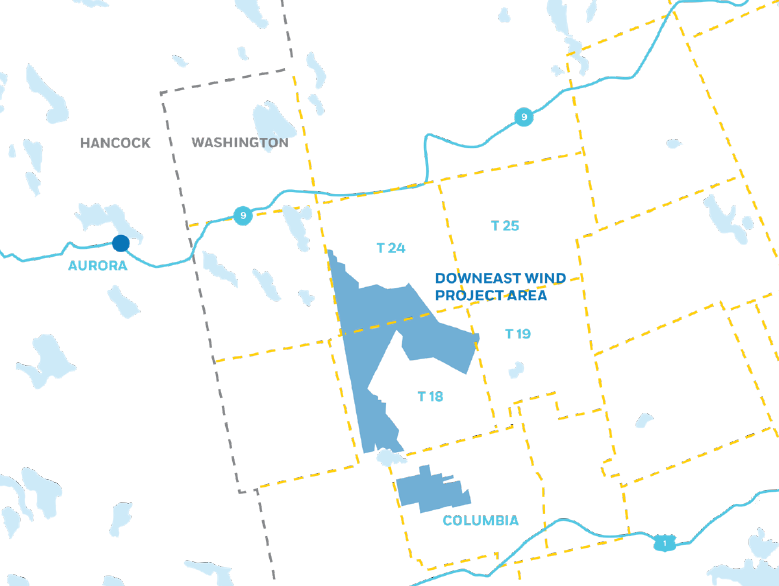Washington County is closer to seeing 30 wind turbines erected by Apex Clean Energy. The Virginia based company through its subsidiary Downeast Wind began the process in 2015.
According to Apex Senior Community Relations Manager Natasha Montague, the construction phase is under way. The company received state approval in 2022 after an examination of its permit application by Maine Department of Environmental Protection.
The wind turbines are being installed along a corridor of land in the Town of Columbia and two sections of unorganized territory (UT), T18 and T24.
The $240-million project will encompass 13,210 acres, have a lifespan of 30 years and will provide 126 megawatts of clean energy, enough to power more than 37,000 homes.
“The team has constructed stream crossings, built new and improved existing roads and established the concrete batch plant. Turbine deliveries will begin in the spring of 2024,” Montague said.
“Turbine erection will begin in the summer and continue through the fall. Construction will wrap up in the winter with the commissioning and testing of the turbines and transmission system.”
Commercial operation is expected to begin in 2025.
The 410 foot tall towers will hold three turbine blades measuring 246 feet in length. Montague says the component parts will be delivered through the port at Searsport. The parts will then be transported and delivered to the pads for assembly. All of the turbines will come online at the same time.
Maine contractors hired
Apex announced the recent hiring of Woolwich-based company Reed & Reed. Montague said, “Reed & Reed is the balance of plant contractor for this project and is responsible for hiring construction subcontractors. The majority of contractors on this project are from Maine.”
Wisconsin based Sanderfoot Wind has been doing the foundation work, with roadwork being overseen by Orono based Sargent Corp. Montague said, “Throughout construction, some workers and contractors from out of state are likely to be used when their skillset or availability are needed to meet project requirements or timelines.”
Other Maine companies working on the project are Owen J. Folsom of Old Town and China based Comprehensive Land Tech.
Montague said, “We supply a list of local businesses that have expressed interest through our local vendor program link on our website. Businesses and individuals that are interested in work can learn more about the services required for the construction and operation of a wind farm and if interested apply directly from the same link.”
Apex estimates the project will create 300 temporary construction jobs and require 10 full time jobs on site, while generating $85 million in local spending through construction, creating an estimated 84 additional jobs.
Revenue impact explained
Washington County Commissioner Chris Gardner commented, “I am impressed with the recent naming of Reed & Reed to now oversee this project as it enters the turbine construction phase.”
In 2020 the county commissioners approved tax-increment financing (TIF) for the project. Revenues generated by the TIF will be split 70/30, with Apex receiving 70% or $6.7 million over 20 years. The Town of Columbia will receive $1.9 million and Washington County UT $3 million.
Gardner noted the county as a whole does not receive the revenue, but Columbia and the unorganized territory do.
“In our purview as commissioners we can utilize some of the revenue for surrounding communities if it is deemed a direct benefit to the UT,” Gardner said.
Stephen Wagner, with the law firm Rudman Winchell, explains the financial agreement and specifically what a TIF does. Revenues associated with the TIF district, T18 and T24, come from the difference in original and developed assessed value of the property.
Being taxed at the pre development assessment avoids reductions in state subsidies brought on by increased valuations.
Wagner said, “A TIF is an economic development tool that shelters and captures the taxes on new investments while protecting the original assessed value of the property. It allows leveraging of the property for projects such as the wind farm.”
After the 20 year TIF payments end, both Columbia and the UT will receive property tax payments from the project. The Town of Columbia will see $150,000 per year for the next 10 years, and the UT will receive annual payments of $230,000.
Additionally, a community benefit agreement (CBA) will provide $3.9 million to the Town of Columbia and $7 million to Washington County over the course of 20 years.
Payments related to both the TIF and CBA, according to Montague, will begin within 180 days after startup of the wind turbines and then continue annually.
A delicate balance
Unlike with the wind project in Columbia, the Town of Jonesport recently passed a 180 day moratorium on wind projects.
For one resident, he believes time needs to be taken on any large scale projects, especially wind, so that their impact, both today and tomorrow, are fully considered.
Larry Balchen said, “I think the moratorium is important because people have to understand and carefully consider what they are potentially signing up for — that being a sea change in what our landscape looks like. A common viewpoint seems to be that these installations will be located out in the sticks, so ‘out of sight, out of mind.'”
“What’s not taken into account is that the topography of Washington County’s coastal plain is relatively flat, making for a viewscape that is vast. One need only travel Rt.1 in Jonesboro where several vistas are evidence of this,” Balchen continued.
“Take note of how many cell towers are visible in the distance, most no more than 200 feet in height, then consider that most wind towers are 650 feet in height, and that doesn’t include site elevation. We need to move ahead carefully; we only have one chance to get this right. We owe it to future generations to do so.”
Of the Downeast Wind project, Gardner said, “From a financial standpoint it made complete sense and was the right thing to do to approve this project. It then falls onto the state and the permitting process to make sure that this is done correctly, safely and responsibly. From what I can tell, it has been.”
Apex says they are taking actions to further lessen impacts to the landscape, such as changing a number of proposed tower sites to minimize visibility, contributing $130,000 to the state’s natural resource protection fund and reducing turbine speeds at night to limit potential harm to bats.
Apex also plans to purchase 700 acres in Jonesport to preserve habitat for migrating birds and has set restrictions on a 500 acre portion of T18 to curtail impacts on sandpipers, a state-listed threatened species.







